We may not have the course you’re looking for. If you enquire or give us a call on 01344203999 and speak to our training experts, we may still be able to help with your training requirements.
Training Outcomes Within Your Budget!
We ensure quality, budget-alignment, and timely delivery by our expert instructors.

Management Styles play a pivotal role in shaping the organisational culture and influencing the overall efficiency and productivity of a team. Different Types of Management Styles reflect distinct approaches to leadership and decision-making, each with its strengths and weaknesses.
According to a Gallup survey, 70 per cent of the employee variance in a team is determined by their managers’ leadership styles. Therefore, it is crucial that managers and team leaders set the appropriate style and tone right from the start to get the most from their teams. In this blog, we will explore 10+ Types of Management Styles, highlighting each of their characteristics and advantages. By understanding these various styles, you can identify the most appropriate approach for your team and business context.
Table of Contents
1) Management Styles and their importance
a) Autocratic Management Style
b) Democratic Management Style
c) Laisses-Faire Management Style
d) Transformational Management Style
e) Transactional Management Style
f) Servant Leadership Management Style
g) Coaching Management Style
h) Charismatic Management Style
i) Bureaucratic Management Style
j) Situational Management Style
2) Tips on how to improve your Management Skills
3) Conclusion
Management Styles and their importance
Effective management is at the core of any successful organisation. The way managers lead, communicate, and make decisions profoundly impacts their team's performance and job satisfaction. Different Types of Management Styles emerge as managers adopt unique approaches to handle their teams and organisational challenges. These Management Styles significantly influence employee morale, engagement, and productivity. When managers adopt a leadership approach that aligns with the team's values and goals, employees are more likely to feel motivated and perform at their best.
Additionally, the right management style can foster effective communication, collaboration, and creativity within the team. On the contrary, a mismatch between the Management Style and team dynamics may lead to conflict, disengagement, and decreased productivity.
By recognising and appreciating different Types of Management Styles, leaders can adapt their approach based on the specific situation and team they are working with. This flexibility enables managers to create an encouraging work environment and build strong bonds with their team members. Let's learn about various Management Styles in detail:
Autocratic Management Style
The Autocratic Management Style, is also known as the Authoritarian Management Style. It is characterised by decision-making, where the power lies with the manager. In this style, the manager makes independent decisions without consulting the members of their team or seeking their input.
The autocratic leader often sets strict guidelines, rules, and policies that must be adhered to by the team. The Autocratic Management Style can lead to quick decision-making and maintaining order and discipline within the team, at the same time also creating apathy or lack of involvement and motivation among employees.
This approach can create resentment that may possibly build into resistance from employees. Besides, few opportunities to provide input by the team can lead to missed opportunities and buy-in on decisions being made. This style is best suited to those situations which require quick action, like real crises, or in industries where safety and compliance regulations are rigid.
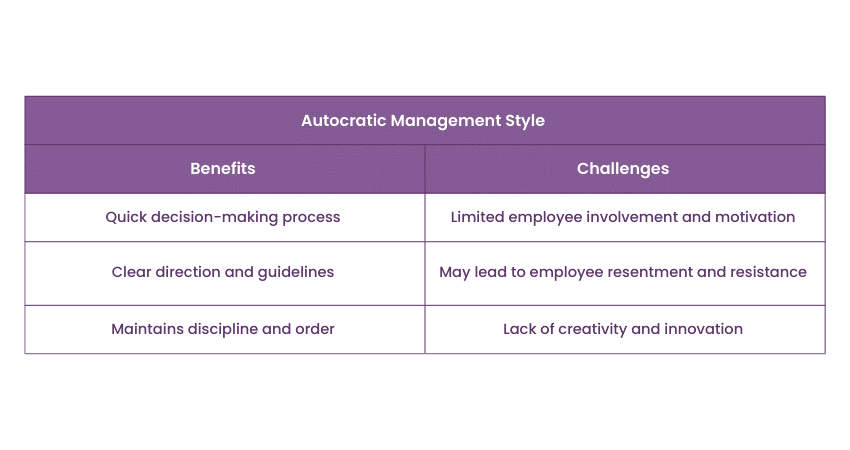
Democratic Management Style
The Democratic Management Style is also known as Participative Management. This approach is characterised by involving employees in the decision-making process jointly.
In this style, leaders do not only allow advice and suggestions from the subordinates but rather empower them to partake in the decision process. Democratic managers allow increased communication and sharing of the power and responsibility in an organisation regarding the direction and goals to work. They foster a culture of shared ownership. This approach not only helps maximise employee involvement and job satisfaction but also gives birth to a sense of ownership and commitment from the team members.
Employees feel valued in the democratic way of setting, which leads toincreased levels of trust and mutual respect between managers and their teams.
This further results in building a diversified range of ideas and perspectives; hence, comprehensive problem-solving on a given problem and coming up with innovative solutions for the arising challenges. Finally, the democratic Management Style ensures the development of a collaborative and inclusive work environment.
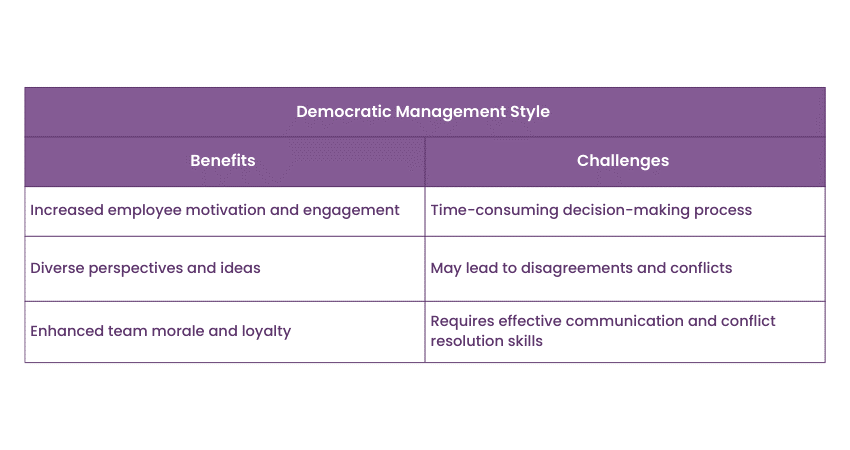
Laissez-Faire Management Style
Laissez-faire is one of the crucial Types of Management Styles. It provides employees with a high degree of independence in the decision-making process. Managers who adapt to this Style of Management avoid intervening directly and instead let the members work on their project or assignment independently.
The leaders adopting the Laissez-faire Management Style believe in their employees’ abilities.. They allow them to operate within their terms without close monitoring. It works best where there is a team with highly creative and self-motivated individuals who are best suited to working in an environment that encourages creativity and independent thinking.
While enhancing creativity and innovation, this may not befit all situations. Employees may get stranded or even lose focus in whatever they are engaged in without enough guidance. Effective communication and regular check-ins, therefore, must be in place to ensure that all the team members are updated with the relevant information.
Transformational Management Style
The Transformational Management Style is a dynamic approach that revolves around inspiring and motivating employees to achieve exceptional results. Transformational leaders are visionary and charismatic, capable of creating a compelling vision that resonates with their team members.
They encourage innovation, creativity, and a willingness to embrace change, inspiring their employees to think beyond conventional boundaries. These leaders focus on individual growth and development and empower their team members to attain their full potential.
Moreover, they build strong relationships based on respect, trust and open dialogue, creating a positive work environment where employees feel valued and appreciated.
By cultivating a sense of purpose and shared vision, transformational leaders foster high levels of employee engagement and loyalty. They encourage continuous improvement and provide the necessary support and resources to help their team members excel. With their inspirational guidance, transformational managers can drive significant positive change within their teams and organisations.
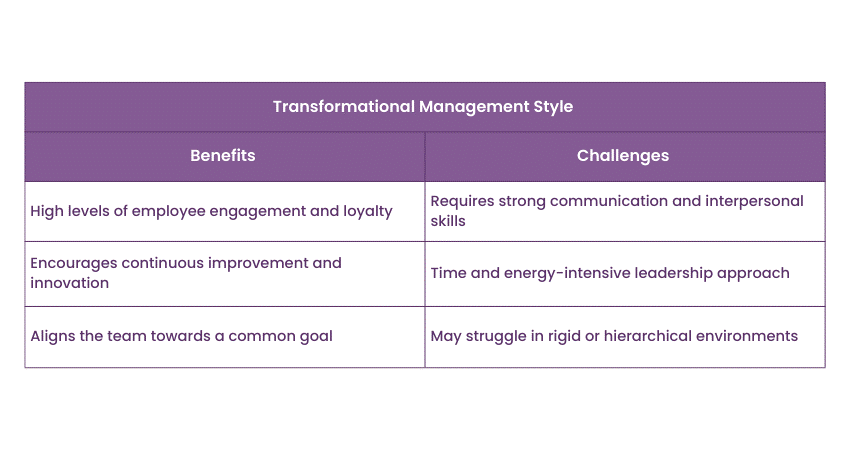
Bring the best out of people with our Introduction to Managing People Course!
Servant Leadership Management Style
Servant Leadership is a Management Style that places the needs of employees above all else. In this approach, leaders prioritise the well-being, growth, and development of their team members. They seek to empower and support them to achieve their full potential. Servant leaders demonstrate high levels of empathy, emotional intelligence, and selflessness, actively listening to their employees' concerns and providing guidance and feedback.
The focus on employee well-being fosters a positive work environment, where team members feel valued and supported. Servant leaders act as mentors, offering coaching and mentorship to help employees enhance their skills and competencies.
By serving their team, these leaders inspire loyalty, dedication, and a strong sense of ownership among employees. Servant Leadership is an effective approach for fostering a culture of trust, collaboration, and employee engagement, resulting in increased job satisfaction and overall team productivity.
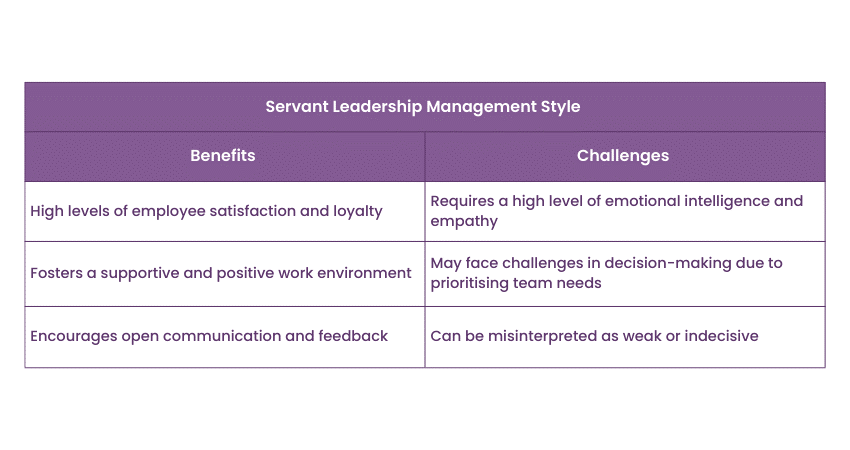
Coaching Management Style
The Coaching Management Style focuses encouraging employees by guiding them and giving regular feedback and promoting culture of learning. A manager using the Coaching Management Style acts much more as a mentor or coach and will not act in an autocratic or traditional boss role. They put effort into the profound understanding of the strong and weak sides of their staff, into setting explicit goals, and reaching them through continuous learning and personal development.
This mode has a lot of benefit in the development of employees in an organisation, since it helps them enhance skills and performance improvement with time. This fosters a positive working environment where the feedback serves to be one way to learn and not a source of criticism. In addition, this approach to coaching creates tremendous team cohesion and loyalty, since the staff feels that the organisation values and supports them in their professional journey.
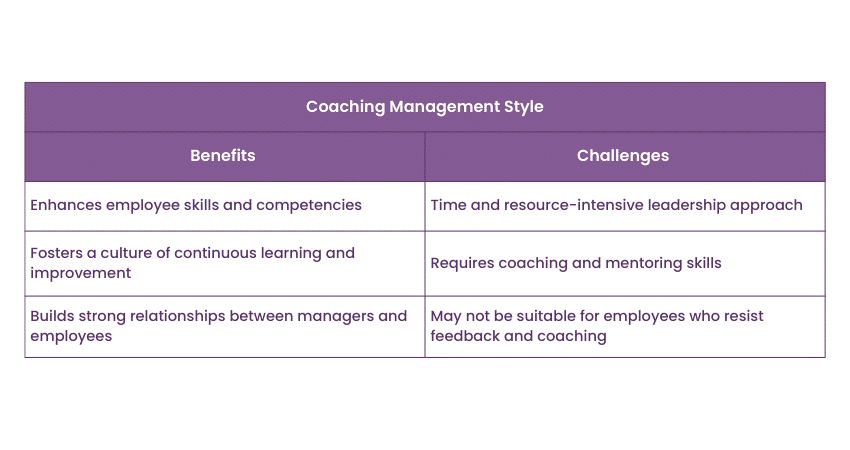
Master verbal and non-verbal communication with our Senior Management Training - register now!
Charismatic Management Style
A Management Style, where the leader has an inspiring vision and is able to motivate their team by the force of personality and activity. Such leaders are able to motivate employees, provoking their rally around one common goal with enthusiasm and engagement.
Mostly, they tend to lead from the front, exposing a very high level of commitment toward organisational goals. This helps inspire the same from their team members. However, the style can also be problematic as it tends to generate dependency on the charisma of a leader and may potentially leave the organisation at risk in the case of such leadership moving on.
Bureaucratic Management Style
The Bureaucratic Management Style is characterised by a strict adherence to rules, policies, and procedures. In a Bureaucratic Management environment, decision-making follows a formalised process, and employees are expected to follow established guidelines diligently. Hierarchical structures and clear reporting lines are prevalent in bureaucratic organisations, with decisions flowing from the top down.
This is also one of the key Types of Management Styles that prioritises consistency and uniformity in decision-making. It helps ensure that operations are carried out in a standardised manner.
Bureaucratic Management can be beneficial in environments where stability and compliance with regulations are paramount, such as government agencies and large corporations. However, leaders may face challenges while adopting the Bureaucratic Management Style. The emphasis on rigid procedures can lead to slow decision-making and hinder innovation and creativity. To succeed in a Bureaucratic Management setting, managers must strike a balance between adhering to established processes and allowing flexibility to adapt to changing circumstances.
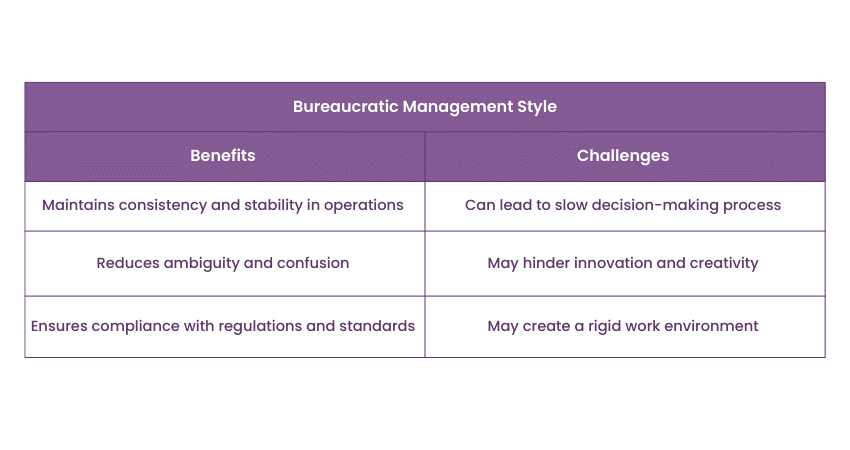
Situational Management Style
The Situational Management Style is a leadership approach that emphasises adaptability and flexibility. In this style, managers adjust their leadership style based on the specific situation and the needs of their team members. They recognise that different circumstances may require different approaches to effectively lead their team and achieve desired outcomes.
Managers employing the situational management style carefully assess the dynamics of their team, considering individual employee needs, abilities, and the complexity of the task at hand. They are responsive to changing circumstances and challenges, and they are willing to use a blend of different management styles as required. This approach allows them to maximise employee performance and satisfaction by tailoring their leadership to suit the unique requirements of each situation. Effective situational managers possess strong Decision-making skills and a deep understanding of individual team members, enabling them to adapt and maintain consistency across different teams and scenarios.
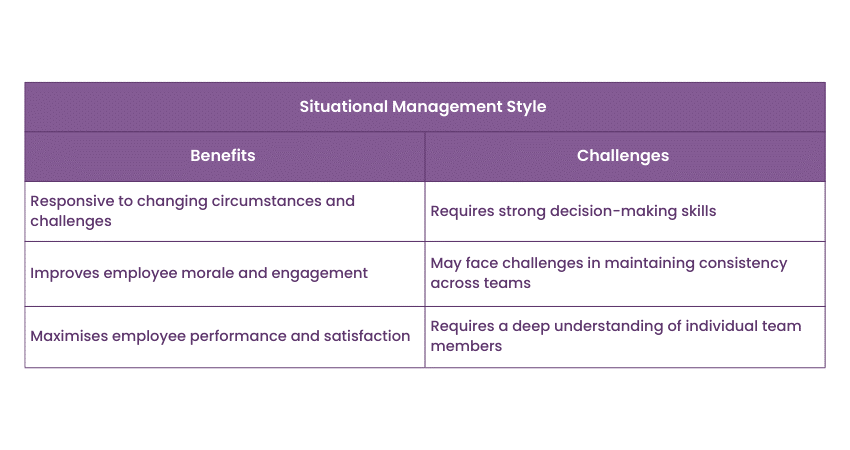
Bring structure and order to events with our Event Management Masterclass!
Paternalistic Management Style
The Paternalistic Management Style is a family-like approach, where the manager takes the role of a parent in taking care and giving guidance to a team. These are known for their Autocratic Decision-making Management Style along with a very strong focus on the welfare of employees and personal well-being.
The Paternalistic Style represents a case where such managers aim at protecting and providing for their employees. They ensure supportive and family-like work enviornment. It may lead to high job security and loyalty to the highest extent, but lack of independence and innovation because the workers have been used to getting instructed and supported by the manager.
Persuasive Management Style
The Persuasive Management Style is centered around the idea of rational persuasion. Managers using this style involve the team by explaining 'what' and 'why,' selling their rationale for decisions to team members and persuading them of the merits.
It involves an open discussion mechanism aimed at motivating the team members and ensuring that they are on the same page. However, it requires strong Communication Skills and sometimes is a time-wasting tactic. It warrants very detailed discussion to ensure that the members of the team are all on board with whatever is decided.
Conflict Management Styles
Conflict Management is another critical aspect of Management that requires managers to effectively navigate disagreements and disputes between subordinates. The general Style of Management could greatly influence their approach to Conflict Management.
For instance, charismatic leaders may use their influence to mediate conflicts by encouraging shared objectives for resolution. Paternalistic leaders are concerned with harmony or disharmony and the personal welfare of the conflicting parties.
On the other hand, a persuasive leader, known for the emphasis on communication, might take an approach to conflict with a free, open discussion pointing at the root of the disagreement through rational argument, pointing out the right and the wrong from both sides until mutual understanding is obtained.
Tips on how to improve your Management Skills
Improving Management Skills is a continual effort that involves self-reflection, learning, and adaptation. This will help you towards improving your skills as a leader and increasing the performance of your team for a better work environment. Let’s find some valuable tips on how to develop Skills in Management:
a) Embrace continuous learning: This practice is crucial for being up-to-date and effective in a constantly changing business environment. It calls for taking an active role in seeking new knowledge, skills, and perspectives from different channels that include books, courses, and professional networks.
b) Develop emotional intelligence: Emotional Intelligence is the key to manage personal feelings and those of other individuals. Building good relations, enabling better communication, and through workplace conflicts greatly depend on the manifestation of emotional intelligence.
c) Enhance communication skills: Effective leadership is based largely on effective communication, meaning clear articulation of thoughts and instructions and also listening to what others have to say. Enhancing these skills can prevent misunderstandings, build trust, and foster a more collaborative team environment.
d) Foster a positive work environment: Creating a positive work environment involves promoting teamwork, acknowledging achievements, and ensuring employees feel valued and supported. This approach boosts morale, increases job satisfaction, and enhances productivity.
e) Adaptability and flexibility: The ability to adapt and be flexible allows managers to respond effectively to changes, challenges, and opportunities in the business environment. This is crucial for solving problems creatively, seizing new opportunities and leading teams through uncertainty.
f) Time management and delegation: It is important for leaders to develop Time Management and delegation skills. They must ensure maximum use of resources in achieving the set relevant goals. Delegation of operations empowers the doer, and this means that prioritisation of work at the departmental level enables the top management to be oriented towards the strategic objectives of the organisation.
g) Seek feedback and reflect: Regularly seeking feedback from peers, superiors, and team members provides valuable insights into your Management Style and areas for improvement. Reflective practice on this feedback and your experiences helps you develop as a leader.
Conclusion
Learning different Types of Management Styles offer diverse approaches to leadership, each with its advantages and challenges. By understanding and appreciating these styles, leaders can develop their flexibility and adaptability in managing their teams effectively. Adopting the right approach or even a mixture of a few of them can lead to enhanced employee engagement, improved productivity, and a positive work environment.
Unlock new sets of managerial skills with our courses in Management Courses!
Frequently Asked Questions

The Management Style to which you respond best depends on your personal preferences, work habits, and professional goals. Thinking about times when you were motivated and felt supported at work can help you determine which management methods work best for you.

Transitioning to a new management style requires self-awareness, learning, and embracing change. Define the aspects of the new style you wish to adopt and seek guidance and training in those areas.

The Knowledge Academy takes global learning to new heights, offering over 30,000 online courses across 490+ locations in 220 countries. This expansive reach ensures accessibility and convenience for learners worldwide.
Alongside our diverse Online Course Catalogue, encompassing 17 major categories, we go the extra mile by providing a plethora of free educational Online Resources like News updates, Blogs, videos, webinars, and interview questions. Tailoring learning experiences further, professionals can maximise value with customisable Course Bundles of TKA.

The Knowledge Academy’s Knowledge Pass, a prepaid voucher, adds another layer of flexibility, allowing course bookings over a 12-month period. Join us on a journey where education knows no bounds.

The Knowledge Academy offers various Management courses, including Business Process Improvement Training, Performance Management Training and Introduction to Managing People. These courses cater to different skill levels, providing comprehensive insights into Reverse Mentoring.
Our Business Skills Blogs cover a range of topics offering valuable resources, best practices, and industry insights. Whether you are a beginner or looking to advance your skills as a Music Producer, The Knowledge Academy's diverse courses and informative blogs have you covered.
Upcoming Business Skills Resources Batches & Dates
Date
 Conflict Management Training
Conflict Management Training
Fri 20th Sep 2024
Fri 1st Nov 2024







 Top Rated Course
Top Rated Course



 If you wish to make any changes to your course, please
If you wish to make any changes to your course, please


